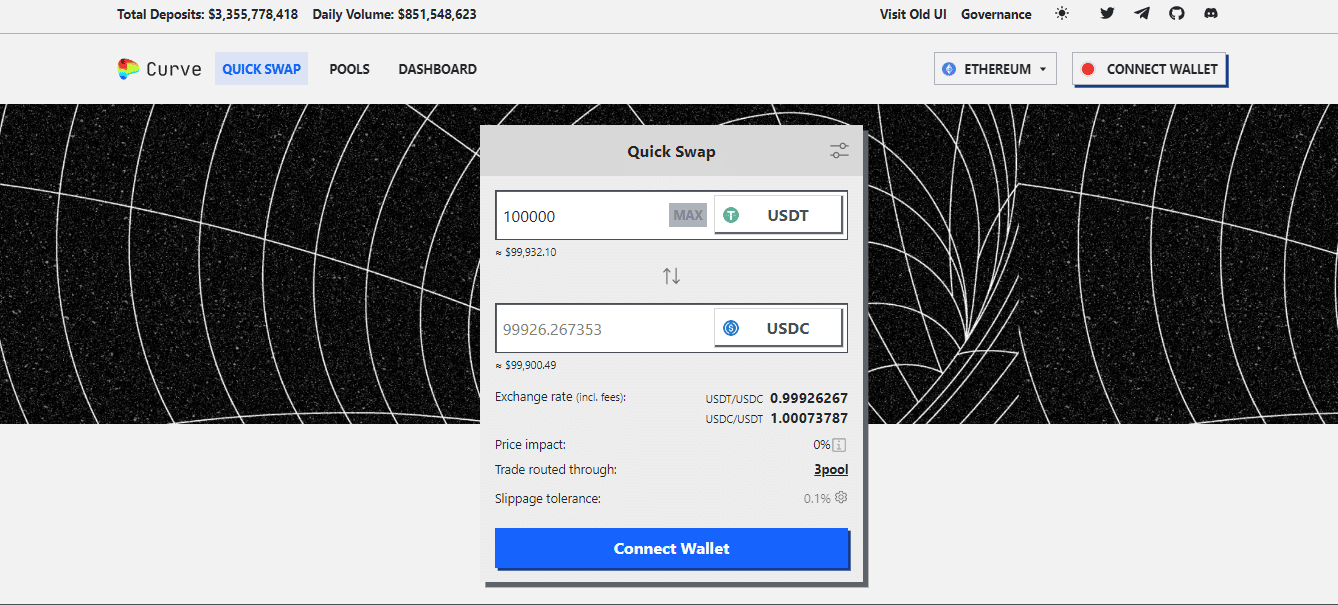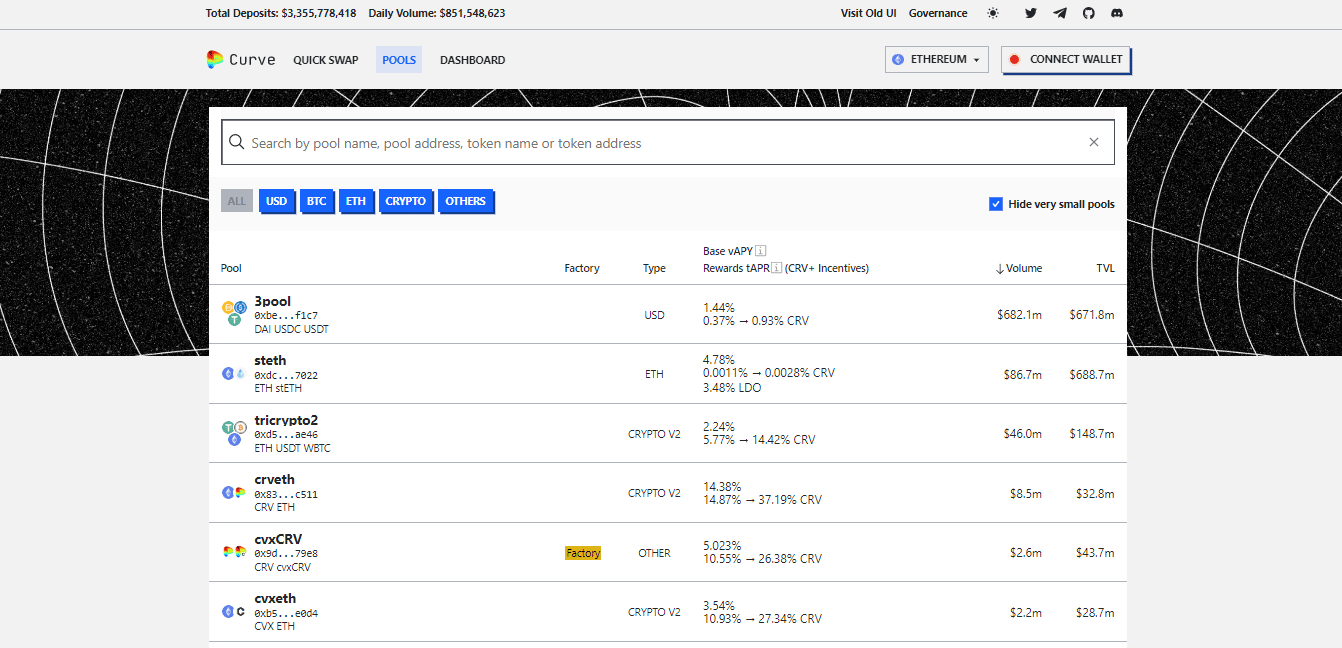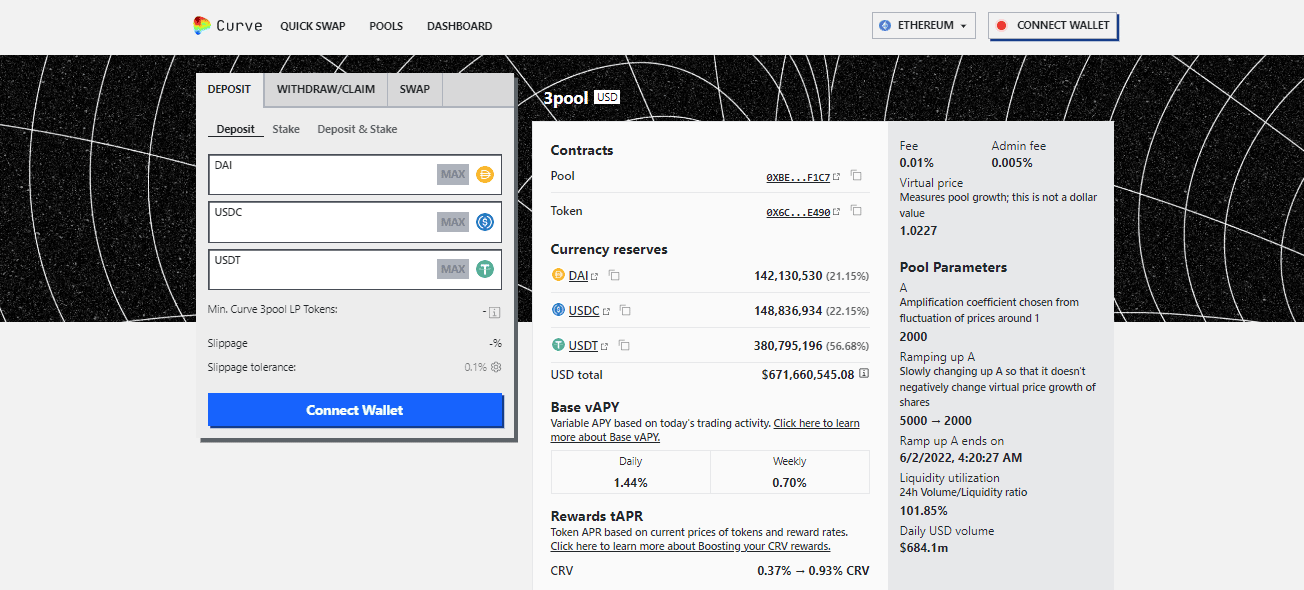- Discussing Curve Finance
- The CRV Token & & Ways to Earn Yield by Staking, Vote Locking, and Voting
- Curve’s Main Competitors
- Curve’s Founding Team
- Last Thoughts: Ahead of the Curve
Curve Finance is a decentralized exchange (DEX) and liquidity procedure developed on the Ethereum network. It’s typically utilized to switch stablecoins with low charges and slippage, in addition to a location to deposit cryptocurrencies into liquidity swimming pools to make trading costs.
Our Curve Finance guide will break down whatever Curve Finance for you; we’ll stroll through how Curve functions, what liquidity swimming pools and AMMs are, how users generate income with Curve, and how the platform compares to other decentralized exchanges.
It’s essential to be clear that cryptocurrency is naturally dangerous, and DeFi items such as Curve are unique and speculative in nature. The innovation is extremely fascinating and can be disproportionately crippling or financially rewarding– acknowledge the threats progressing.
Discussing Curve Finance
Curve is a decentralized exchange that enables users to switch several stablecoins, that much we currently understand.
While 2 or more stablecoins must remain in the exact same dollar variety (1 USDC=1 USDT), there’s constantly some level of slippage when switching in between 2 of themThe bigger the amount, the greater the slippage.
If you desire to trade 100,000 USDT for 100,000 USDC, you might just end up with 99,900 USDT due to slippage.
Curve utilizes the Curve Constant formulacomparable to that of Uniswap’s, to decrease slippage and trading costs.
The opposite of Curve is the liquidity procedure, and it’s much better to comprehend what automated market makers (AMMs) are and how they operate in decentralized exchanges:
- Curve depends on an AMM, which is a software application system that prices estimate costs in between 2 various possessions utilizing a mathematical formula. When it comes to Curve, it prices quote rates in between 2 stablecoins or covered variations of cryptocurrencies, like covered Bitcoin (wBTC) and covered Ethereum (wETH).
- AMMs are various from order bookswhich are normally utilized by central exchanges (CEX), in the sense that they count on liquidity suppliers, which are the users, and other DEXs. Both users and DEXs deposit cryptocurrencies into one or several liquidity swimming pools to show a well balanced cost in between one or numerous properties.
- On the other hand, a central exchange utilizing the”order bookmethod will have a deep swimming pool of possessions in its custody if required to offer liquidity for different trading sets.
Liquidity suppliers are the foundation of decentralized exchanges; without them, a DEX would be illiquid and not able to meet trades at sensible costs. Given that a DEX does not hold custody of its users’ properties, it should offer rewards for them to supply liquidity.
Yield farming is the act of supplying liquidity– transferring funds– into a liquidity swimming pool so other users can make trades with several possessions. The procedure then pays a portion of trading costs to liquidity suppliers as a reward.
Like many liquidity procedures, the quantity of charges ( the average is 0.04%paid to liquidity service providers depends upon trading volume; the greater the volume, the greater the costs, and for that reason the greater the APY (Annual Percentage Yield).
Curve’s site appears like a basic Web1 user interface from the late 90s, however it’s fairly simple to browse as soon as you get utilized to it.
To utilize Curve, you require to link your cryptocurrency wallet, like MetaMask, Coinbase Wallet, or WalletConnect.
The very first area we’ll see fasts Swap, which enables you to switch over 100 properties consisting of stablecoins and covered coins.
The area will reveal you the exchange costs, and the swimming pool in which the exchange will occur. If we switch USDT to USDC, the procedure will path it on 3pool, which has the biggest volume and TVL (Total Value Locked) for DAI, USDC, and USDT.
To inject liquidity to a swimming pool, just select a swimming pool from the list and click Deposit. A deposit user interface will appear with various coins to deposit. The procedure rewards you with a deposit perk if you offer liquidity to the cryptocurrency with the most affordable balance. In this example, DAI.

There are 2 methods of transferring: typical deposit, and stake & & gauge, which stakes your tokens without lock-up durations, so you can unstake them whenever you want to. This choice permits you to make CRV tokens as benefit, however you still get a part of trading charges.

Curve vs. Balancer
Both Curve and Balancer work as decentralized exchanges and AMMs with rebalancing systems. The primary distinction in between the 2 is that Curve utilizes stablecoins and covered variations of Bitcoin and Ethereum.
When a user transfers a DAI to a USDT/DAI swimming pool, then the swimming pool ends up being out of balance because the DAI balance is larger than USDT. The procedure then offers DAI at a small discount rate in concerns to USDT to stabilize the USDT to DAI ratio. In this example, volatility and impermanent loss are lessened because the procedure is dealing with stablecoins.
On the other hand, users transfer 2 or more cryptocurrencies into a Balancer liquidity swimming pool wishing to optimize returns with the intrinsic threat of volatility. Balancer swimming pools can be made up of as much as 8 cryptocurrencies, while Curve swimming pools typically host 3 stablecoins.
The CRV Token & & Ways to Earn Yield by Staking, Vote Locking, and Voting
CRV is an ERC-20 token that has 3 primary usages:
- Staking: users secure CRV to make trading costs from the Curve procedure. The basic APY is 4%
- Vote locking: securing CRV for a particular duration and getting vote-escrowed CRV (veCRV), which are tokens that offer users voting power and an increase of approximately 2.5 x on the liquidity they offer to Curve’s liquidity swimming pools.
- Ballot The Curve DAO is where users vote on network specification modifications or send their own propositions.
The CRV preliminary supply is 1.3 billion tokens, and the overall supply is topped at 3.03 billion tokens.
The circulation of CRV is as follows:
- 30% to the advancement group and financiers
- 60% to liquidity suppliers
- 5% to pre-CRV liquidity companies, 1-year vesting
- 5% to the neighborhood reserve
Curve’s Main Competitors
Balancer: a self-balancing possession management platform that works likewise to a standard index fund however with decentralized functions. Its swimming pools are divided into public, personal, and wise classifications and can accommodate approximately 8 cryptocurrencies.
SushiSwap: a leading decentralized exchange developed on the Ethereum network and a fork of a widely known DEX in the DeFi area, Uniswap
PancakeSwap: a DEX developed on top of the Binance Smart Chain (BSC), and supports other networks such as Ethereum and Aptos. It likewise incorporates a market where users can note, purchase, offer and trade non-fungible tokens (NFTs)
Osmosis: a popular DEX and advancement platform constructed on the Cosmos blockchain, enabling users to negotiate cryptocurrencies through various blockchains and to construct Web3 applications utilizing SDK and other designer resources.
Curve’s Founding Team
Michael Egorov developed Curve in January 2020. Prior to Curve, he developed and led NuCypher and LoanCoin. Information about the advancement group are limited, so no one actually understands extensive who else worked on the development of Curve.
Curve is among the biggest automatic market makers (AMM) by market cap, sitting at the 4th area with a market cap of over $510 million, according to CoinGecko
Last Thoughts: Ahead of the Curve
Yield farming is a popular practice in the DeFi area, where liquidity companies want to put their tokens to work by transferring them into liquidity swimming pools. In DeFi, with excellent APY comes fantastic threat, such as volatility, impermanent loss, cost crashes, platform disaster, and even hacks.
Because Curve prefers stability over volatility, those who desire to leap in on the insane world of yield farming however have a lower hunger for threats can discover Curve as an useful choice to beginning point
Never Ever Miss Another Opportunity! Get hand chosen news & & information from our Crypto Experts so you can make informed, notified choices that straight impact your crypto earnings Sign up for CoinCentral complimentary newsletter now.
